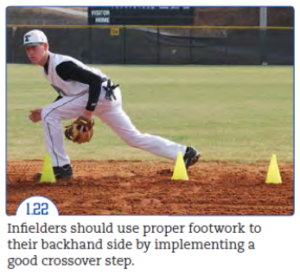Source: Trent Mongero, Winning Baseball
Video: Trent Mongero, Backhand Mechanics (5 min) ![]()
As with all types of ground balls, backhand plays offer a unique set of challenges that players must overcome. Initially, the fielder’s footwork is exactly the same as preparing for any batted ball. For example, the player will creep into a ready position. However, once the ground ball is hit to the fielder’s right (backhand play will be made to the right of a right-handed thrower), he must make critical adjustments to efficiently get to the ball, field it cleanly on the backhand side, and accurately throw to first base.
When to Use Backhand Mechanics
When a player takes a good crossover step and establishes a good angle to a ball on his backhand side, he may realize that he can actually get in front of the ball to field it. Typically this is beneficial. However, if the player feels like he will have to sacrifice good fielding mechanics in order to “fight” to get his body in front of the ball, he should simply play the ball to his backhand side (Figure 1.24).
Flaw: Lazy Feet
When a player approaches the ball with lazy feet, it forces him to field the ball to his backhand side when he should have played the ball in front of his body.
Crossover Step
Once the ball is hit, the fielder must react by taking a crossover step with his left foot to his backhand side. As he is stepping across his body, the fielder must stay low to the ground and simultaneously determine the distance and speed of the batted ball. This will impact when and where he will put down his left foot to help him take the best angle to the ball. For instance, if the fielder determines that the only way to catch this ground ball is to intersect it deep on the infield, he should create a deeper angle to the ball by putting his left foot down where he can make a straight line to the ball’s path. When a player mistakenly takes the first step with his right foot to make a backhand catch, he has made a “false step.” Very little ground is gained on this preliminary movement, and it can cause the fielder to be late and miss the ball.
Do or Die Backhand Play
A do-or-die backhand play is one in which the player does not have a choice about how the ball is fielded. He will either catch the ball with backhand mechanics of dive after the ball. As the fielder attacks the ball, quickly moving his feet, he must simultaneously lower his body to bring his nose down to the ball just before making the catch. This is no time to choose which foot will be out in front when the ball enters the glove. The player should take a split second to make sure the ball is secured in the glove and then quickly transition his feet to get his body into a power position to throw to first base.







